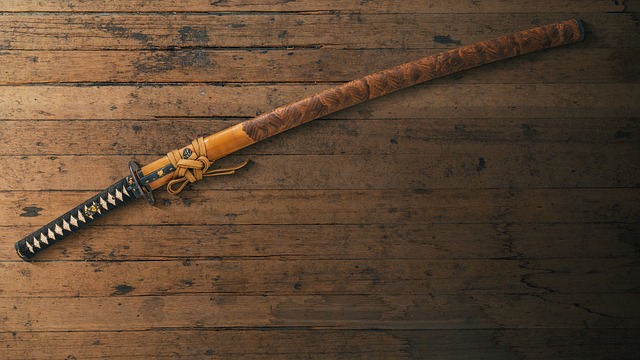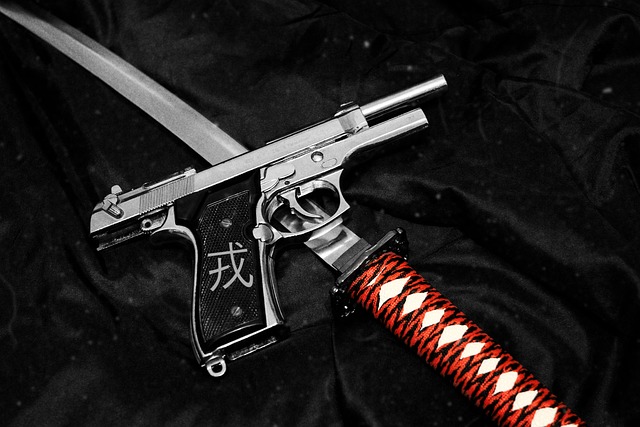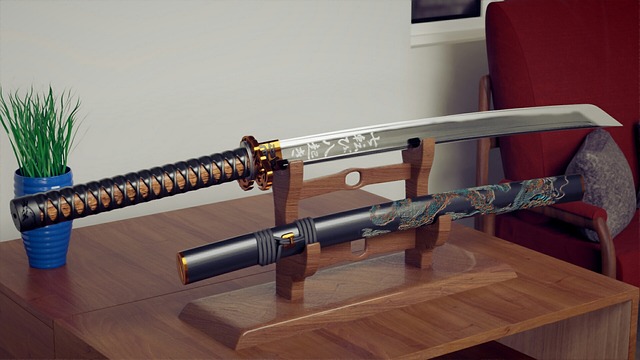A katana is typically extremely sharp, with a finely honed edge. It is a Japanese sword known for its sharpness and cutting ability.
Additionally, its sharpness depends on craftsmanship, steel quality, and sharpening techniques. Historically, folded and layered steel contributed to the sharpness.
Moreover, modern replicas might not match traditional sharpness. Proper training is essential due to the potential for serious injuries when handling a sharp katana.
What Are The Factors Affecting Katana Sharpness?
The sharpness of a katana is a harmonious interplay of metallurgy, technique, and care, where even the slightest factors can yield profound effects.
Craftsmanship of the Swordsmith
The craftsmanship of the swordsmith plays a crucial role in determining the sharpness of a katana. Traditional Japanese swordsmiths were skilled artisans who meticulously crafted each katana.
In addition, the expertise they brought to forging, shaping, and tempering the blade significantly impacted its sharpness. A master swordsmith would carefully shape the blade’s geometry.
Moreover, ensure that the edge is thin and keen while maintaining the necessary structural integrity. The skill of the swordsmith influenced the overall balance of the katana, which in turn affected its handling and cutting performance.
Quality of the Steel Used

The choice of steel has a direct impact on the sharpness and overall quality of a katana. Traditional Japanese katanas were often made using a combination of different types of steel.
For example, as a high-carbon steel for the edge and a lower-carbon steel for the body of the blade. This combination allowed for a hard, sharp cutting edge while maintaining flexibility in the body.
Moreover,it prevents the blade from being too brittle. The composition and purity of the steel influenced the blade’s ability to take and hold a sharp edge.
Sharpening Techniques Applied
Sharpening a katana involves carefully honing the blade to achieve the desired level of sharpness.
In addition, the sharpening process is a delicate balance between creating a fine, razor-sharp edge and preserving the blade’s structural integrity.
Moreover, traditional sharpening techniques involve using various types of stones with different grits to refine the edge gradually.
In addition, the angle at which the blade is sharpened, the pressure applied, and the consistency of the sharpening strokes all contribute to the final sharpness of the edge. Furthermore, a well-sharpened katana requires expertise to ensure that the edge is keen and symmetrical.
What Are Historical Sharpness of Katana Blades?
Journeying through history, the razor-sharp edge of katana blades has been both a testament to Japanese swordsmithing mastery and a reflection of the era’s metallurgical advancements
Traditional Process of Folding and Layering Steel
The traditional process of creating a katana involved folding and layering steel, which played a pivotal role in enhancing the blade’s sharpness and strength.
Moreover, swordsmiths in ancient Japan used a technique called “tamahagane” to create the steel for their blades.
In addition, tamahagane involved smelting iron sand and charcoal in a special furnace, resulting in steel with varying carbon content.
This raw steel was then repeatedly folded and hammered, creating layers that removed impurities and evenly distributed the carbon.
Furthermore, the folding process could result in hundreds or even thousands of layers, depending on the swordsmith’s preference.
Contribution to Sharpness and Strength
The folding and layering process had several benefits for the katana’s sharpness and strength. Moreover, the repeated folding and hammering eliminated impurities, creating a purer and more homogeneous steel.
In addition, this allowed for a finer grain structure, which contributed to the blade’s resilience and ability to hold a sharp edge. The layered structure also distributed stresses and strains more evenly throughout the blade, preventing it from becoming too brittle or prone to breaking during combat.
On the other hand, the combination of high-carbon steel at the edge and lower-carbon steel in the body resulted in a hard edge. That could be sharpened to an exceptional degree, while the body maintained the necessary flexibility.
Examples of Historical Cutting Feats
Historical accounts and legends abound with stories of the incredible cutting feats performed by katana-wielding warriors.
Moreover, these feats demonstrated the remarkable sharpness and cutting ability of well-crafted katanas.
One famous example is the test of cutting through multiple bodies (tameshigiri) to showcase a katana’s effectiveness. Skilled swordsmen could cleanly slice through bamboo, straw mats, or even human bodies with a single stroke.
In addition, this ability was not only a testament to the blade’s sharpness but also to its design, balance, and the skill of the swordsman. Such feats solidified the katana’s reputation as a deadly and revered weapon.
What are The Modern Variations in Sharpness?

Exploring the modern landscape of katana blades unveils a spectrum of sharpness variations influenced by advancements in materials.
Differences in Replica and Decorative Katanas
In the modern era, there are various types of katana replicas and decorative swords available, which may differ significantly in terms of sharpness. In addition, some replicas are mass-produced for aesthetic purposes or collectibles. And might not possess the same level of sharpness as authentic, functional katanas.
Moreover, these replicas are often designed to mimic the appearance of traditional katanas without the same level of craftsmanship or attention to detail.
Practical Use versus Display Purposes
Modern katanas can be categorized into those designed for practical use and those intended solely for display purposes. Moreover, functional katanas are crafted with an emphasis on both historical accuracy and performance. In addition, these blades are made with the intention of being used for martial arts training, cutting practice, or even combat simulation. On the other hand, display katanas are primarily meant for showcasing and may not be as sharp or functional.
Adjusting Sharpness for Intended Function
Depending on the intended use, modern katanas can have their sharpness adjusted accordingly. For functional katanas, swordsmiths or skilled craftsmen consider the blade’s geometry, steel composition, and tempering process. Moreover, they create blades that strike a balance between sharpness and durability.
Furthermore, the edge is honed to a level suitable for effective cutting, while the blade’s structural integrity is maintained.
For display katanas, the sharpness might be reduced or even eliminated to prioritize safety and prevent accidents during handling.
How can you handle and exercise caution?
Navigating the realm of katana sharpness demands a delicate balance between skillful handling and exercising caution.
Importance of Proper Training
Handling a katana requires proper training and expertise. The techniques for drawing, striking, and sheathing a katana safely and effectively are essential components of traditional Japanese martial arts such as Kenjutsu and Iaido.
Without proper training, individuals risk mishandling the weapon, leading to accidents or injuries. Training not only teaches the physical aspects of using a katana but also instills the necessary discipline and understanding of its capabilities.
Potential for Serious Injuries
The sharpness of a katana’s blade gives it incredible cutting power. Mishandling or improper use can lead to severe injuries, including deep cuts or even dismemberment.
Even a slight miscalculation or a moment of inattention can result in a serious accident. This is why proper training and respect for the weapon’s potential are crucial when handling a katana.
Respect for the Katana’s Cutting Power
The katana holds cultural and historical significance beyond its physical attributes. It symbolizes the warrior spirit, discipline, and honor in Japanese culture.
Moreover, recognizing and respecting the cutting power of a katana is not only about avoiding accidents but also about understanding the weapon’s legacy. This respect extends to how the katana is cared for, displayed, and used.
FAQ’s
Can a katana cut bone?
Yes, a katana’s sharp edge can cut through bone with enough force.
Can a katana cut a human in half?
While a katana is sharp, cutting a human in half with one swing is unlikely due to various factors.
Can a katana really cut a bullet?
It’s highly improbable for a katana to cut a bullet due to the bullet’s high speed and hardness.
Can a katana go through a skull?
Given enough force, a katana could potentially cut through a skull.
Can a katana slice a head?
Yes, a katana’s sharp edge could slice through a head with sufficient force.
Can a katana cut through rock?
No, a katana is not designed to cut through solid rock.
Can a sword split a skull?
Yes, a well-aimed and forceful strike from a sword could split a skull.
Conclusion
The katana’s reputation for sharpness and cutting ability is a result of a complex interplay of factors that have evolved over centuries. Craftsmanship, steel quality, and sharpening techniques have historically contributed to the exceptional sharpness of the katana.
In addition, The traditional process of folding and layering steel, meticulously carried out by skilled swordsmiths, gave rise to a blade that merged sharpness with strength.
Modern variations in sharpness include functional katanas designed for practical use and display katanas meant for aesthetic appreciation. The careful balance between sharpness and durability is achieved through the consideration of blade geometry, steel composition, and intended function.
However, the sharpness of a katana brings forth the necessity for responsible handling and caution. Proper training is vital to master the art of wielding a katana safely and effectively. The potential for serious injuries underscores the importance of discipline, concentration, and a deep understanding of the weapon’s capabilities.
Additionally, beyond its physical attributes, the katana demands respect for its cultural and historical significance, embodying traditions, honor, and the spirit of the warrior.

